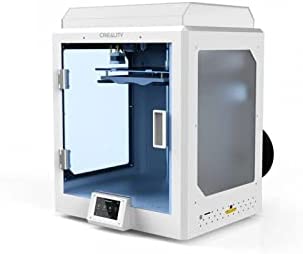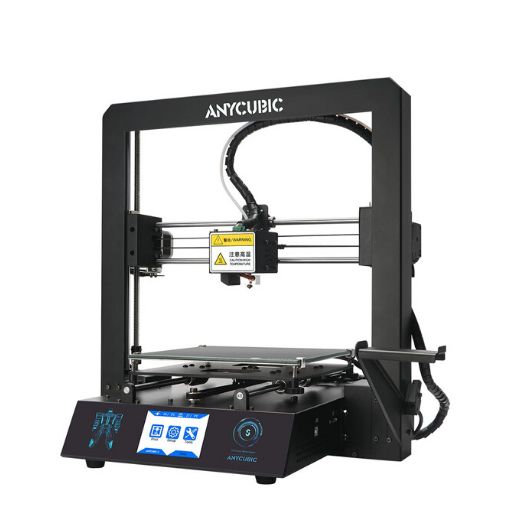Compare CR5 PRO H vs Mega S
Comparison between the best 3D printers
Choose the best 3D printer at the best price. The cheapest 3D printers are here.
Buy a 3D printer here with 3D Fila.
 |
 |
|
| Model | CR5 PRO H[BUY CR5 PRO H] |
Mega S |
| Printing Material | Filament | Filament |
| Buy Filament for Creality 3D CR5 PRO H | Buy Filament forAnycubic Mega S | |
| Estimated price | $1300,00 | $149,00 |
| Manufacturer | Creality 3D | Anycubic |
| Release Year | 2022 | 2019 |
| Print Volume [mm] | 300x225x380 | 210x210x205 |
| Printer Size [mm] | 530x487x612 | 405x410x452 |
| Weight [kg] | 32,5 | 14,5 |
| Power Loss Recovery | YES | YES |
| Enclosed printer | YES | NO |
| Bed Leveling | Automatic | Manual |
| Filament End Sensor | YES | YES |
| Bed type | Heated | Heated |
| Power supply system | Bowden | Bowden |
| Standard nozzle | 0,4 | 0,4 |
| Maximum Nozzle Temperature [°C] | 300 | 260 |
| Maximum Bed Temperature [°C] | 100 | 110 |
| Maximum printing speed [mm/s] | 100 | 100 |
| Filament holder | YES | YES |
| Camera for supervision | NO | NO |
| Recommended filaments | PLA, PETG, Tritan, Flex, ABS | PLA, TPU, ABS, PETG |
| Recommended slicers | Cura, Simplify, Slic3r, IdeaMaker | Cura, Simplify, Slic3r |
| Maximum Resolution [mm] | 0,1 | 0,1 |
| Processor | ATMEGA 2560 | 8 bits |
| Display | Display touchscreen 4,3'' | Touchscreen TFT 2,8'' |
| Power Supply | 110/220V / 350W | 12V / 300W |
| Connectivity | SD / USB | SD / USB |
| Operating systems | Windows, Mac, Linux | Windows, Mac, Linux |
| Date of registration in the system | 2022-11-04 | 2021-04-15 |
| Release date | 2022 | 2019 |
| Extra features | The Creality CR-5 PRO H 3D Printer stands out with a high-temperature nozzle (up to 300°C), a 300 x 225 x 380mm print volume, and a closed chamber for thermal stability. It includes BLTouch auto-leveling, a carbon-crystal silica glass base for easy model grip and removal, a filament sensor, and a resume print function. It has a 4.3-inch touchscreen interface, quiet operation, an attractive design, and is pre-assembled, ideal for technical materials. | The Anycubic Mega S offers a printing platform with excellent adhesion, easy removal after cooling. It has a filament sensor for a better experience with flexible materials and a multilingual and intuitive color touchscreen. Assembly is quick, requiring only 8 screws and 3 connections. It has a large build volume (210 x 210 x 205 mm), high positioning accuracy and supports a variety of materials, including TPU, PLA, ABS and wood. It stands out for its solid metal structure, superior stability, high-quality printing with layer resolution of up to 50 microns, Ultrabase for easy adhesion and removal of parts, resumption of printing after power outage, high-quality extruder for flexible filaments, suspended filament support and stable structure that reduces shaking, improving printing quality. |
| Support for multiple colors and materials (AMS and CFS) | NO | NO |
Notes * |
||
| Cost-benefit | 6 / 10 | 7 / 10 |
| Hardware | 3 / 10 | 2 / 10 |
| Tela | . | . |
| Print volume | 4 / 10 | 3 / 10 |
| Performance | 1 / 10 | 1 / 10 |
| [BUY CR5 PRO H] |
Conclusion |
| In conclusion, choosing between the Creality CR-5 PRO H and the Anycubic Mega S ultimately depends on your specific printing needs and budget constraints. The CR-5 PRO H is a more advanced option with superior capabilities, such as a larger print volume, higher maximum nozzle temperature, an enclosed design for better thermal stability, automatic bed leveling, and a touchscreen interface, making it ideal for technical materials and more complex projects. However, it comes at a significantly higher price point. On the other hand, the Anycubic Mega S offers excellent value for its cost, providing reliable performance with a decent print volume and compatibility with various materials. Its straightforward assembly and solid construction make it appealing for beginners and hobbyists. While it lacks some of the advanced features found in the CR-5 PRO H, it serves as a capable and cost-effective solution for those who prioritize affordability and ease of use. Overall, if budget is a primary concern and you're looking for solid performance without the frills, the Anycubic Mega S is a wise choice. However, if you're ready to invest in a more robust printer with advanced features and greater versatility, the Creality CR-5 PRO H would be the better option. Both printers have their strengths, and the decision should reflect your printing goals and financial considerations. |

